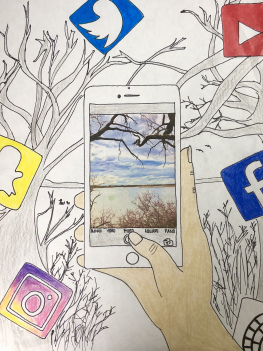
When I read the question “what does the environment mean to you?” I thought of many things. To me, the word “environment” basically means our surroundings. For example, it could be an indoor environment such as home or school or an outdoor environment such as a park, forest, farm, or lake. After being assigned the task to create a visual that reflects a specific story of a time that I felt connected to the environment, I was able to think of several stories. I thought about my childhood, playing in the park, growing marigolds in my little garden, picking apples, carrots, and tomatoes from my backyard, but I also thought about my trips to the lake, swimming, boating, taking hikes, as well as my trips to different places around the world, such as the Rocky Mountains in Alberta or the beautiful islands of the Philippines. All these ideas came to my mind, but I could not think of a way to represent them all – until we did the practicing stillness activity.

During the five minutes of silence and reflecting, I took the time to think of what to do for my visual. During this time, I caught myself taking a picture with my phone to post onto Snapchat to share with my friends and family. At that moment I realized that every time I am outside, I am so attached to my phone that I don’t take the time to truly appreciate my surroundings. I’m either trying so hard to take a good picture to post or I am distracted looking at other posts or texts that I don’t stop to appreciate the beauty around me. After realizing this, I thought about the times I spent in the environment as a child and noticed that as a child, I was able to look deeply into nature and notice the little things such as the different insects and animals, the sounds of the birds, the smell of the air, dirt, and sand, feel the different textures, but as I grew up, I became too absorbed into social media that I stopped truly appreciating what nature has to offer. With that, for my visual I drew a picture of a hand holding a phone, taking a picture. The picture displayed on the phone is the picture I took during our practicing stillness activity. I put a few social media logos floating around to represent the distraction social media or our phones can cause. The background of the drawing is all grey and white to represent what we are missing when we are too focused on our screens.
In the story Sounds of Silverbells by Robin Wall Kimmerer, she was so distracted with trying to prove to the dean that the pre-med students would learn something through this fieldtrip that she forgot her ultimate goal of encouraging the students to truly experience and appreciate nature the way she did. In other words, she was so focused on trying to impress someone that she loses herself and her beliefs through the process. Similarly, when I am out in the wilderness or on a vacation somewhere in nature, whether it be at the lake, beach, or mountains, I constantly find myself distracted with trying to take the perfect picture to post onto my Instagram or snapchat story or to take the perfect Facebook profile or cover picture that I forget to take the time to appreciate where I am in the moment. With that, something I would like to do to connect deeper with nature, is to stray away from using my phone or social media and take the time to stay in the moment and appreciate nature. I would like to have the same senses I did as a child and relearn how to connect with the environment with no distractions or expectations.
William Hammond’s article The Creative Journal: A Power Tool for Learning discusses that journal keeping is more than just recording observations and data.
“Once translated verbally and graphically into a journal it is fixed in memory and archived for future reinforcement. The EE journal helps the journaler develop a personal connection to the local environment. More than a place for recording observations and data, it is a springboard to fresh insights and new discoveries. It helps learners recognize patterns in the environment, compare and contrast the patterns and relationships of objects and events, and discern discrepant events and pattern changes. It is a place to reflect upon these discoveries, to hypothesize how they happen, and to revisit, critique and revise ideas.” (Hammond, 34)
Moreover, journaling helps us reflect on and better recognize our environment, which is what I believe I had the chance to experience during this first journal and will continue to do throughout the course and hope to continue to do after completing the course.
